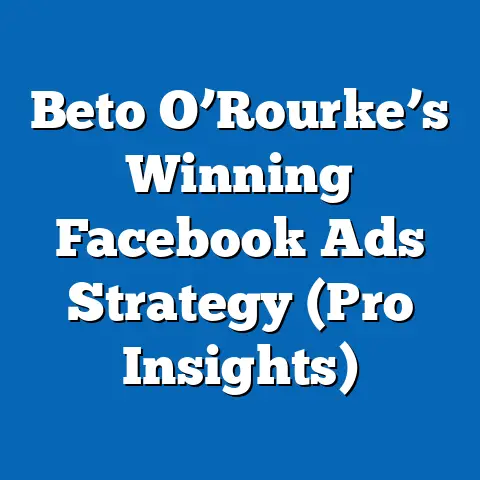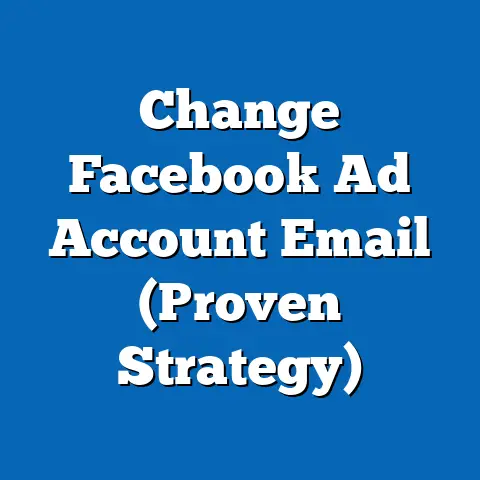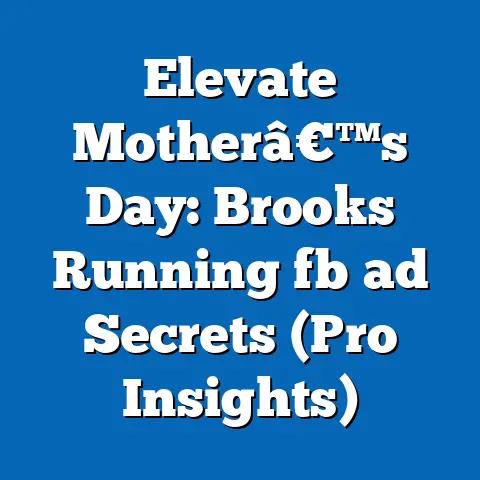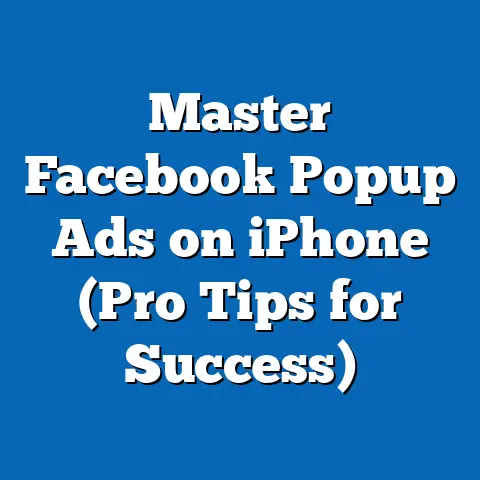Why Is My Facebook Feed Only Ads? (Insightful Analysis)
Have you ever found yourself endlessly scrolling through your Facebook feed, only to be met with an overwhelming number of ads, leaving you wondering where all your friends’ and family’s updates have gone? It’s a common frustration, and trust me, you’re not alone. For years, I’ve been navigating the world of Facebook advertising, both as a marketer and a user, and I’ve witnessed firsthand the gradual shift towards an ad-centric experience.
Understanding why your Facebook feed feels like an advertising billboard is crucial, not just for your own sanity, but also for businesses trying to navigate this evolving landscape. Are you seeing more ads because Facebook is greedy? Is it something you’re doing? Is it the fault of the algorithm? In this article, I’ll dive deep into the reasons behind the increasing prevalence of ads on Facebook, exploring the platform’s business model, the intricacies of its algorithms, and the impact of user behavior. I’ll also share my personal experiences and insights, to help you understand the dynamic between ads, algorithms, and your personal Facebook experience.
My goal is to provide you with a clear understanding of why your feed is the way it is, helping you to make informed decisions about how you use the platform, and how businesses can navigate it effectively.
Key Takeaways:
- Facebook’s Business Model: Advertising is the lifeblood of Facebook, driving the platform’s revenue and growth.
- Algorithmic Prioritization: Facebook’s algorithms prioritize ads based on factors like engagement rates, user behavior, and advertiser budgets.
- Targeted Advertising: User data is used to personalize ads, making them more relevant but also potentially intrusive.
- User Engagement: Your interactions on Facebook influence the algorithm, shaping the content you see.
- Sponsored Content: The rise of sponsored content and influencer marketing blurs the line between ads and organic posts.
Understanding Facebook’s Business Model
Let’s face it, Facebook is a business, and like any business, it needs to generate revenue to survive and thrive. The primary source of that revenue? You guessed it: advertising. While Facebook started as a platform for connecting friends and family, it quickly evolved into a powerful advertising platform.
I remember when Facebook first introduced ads. They were simple, almost rudimentary, appearing on the sidebar and easily ignored. But over time, they became more sophisticated, more integrated into the feed, and ultimately, more prevalent. This shift wasn’t accidental; it was a strategic move to capitalize on Facebook’s massive user base and unparalleled data collection capabilities.
According to Meta’s (Facebook’s parent company) latest earnings reports, advertising revenue accounts for the vast majority of their total revenue. In 2023, Meta generated over \$130 billion in advertising revenue globally. That’s a staggering number, and it underscores the importance of advertising to Facebook’s bottom line.
The transition from organic content to paid promotions has been a gradual but significant one. In the early days of Facebook, businesses could reach a large audience simply by creating a Facebook page and posting engaging content. However, as the platform grew and became more crowded, organic reach declined dramatically. This decline wasn’t a coincidence; it was a deliberate strategy to encourage businesses to pay for advertising.
I’ve seen this firsthand with my own clients. What used to be a free and easy way to connect with potential customers has now become a pay-to-play game. While organic content still has value, it’s simply not enough to reach a significant audience without investing in advertising.
Takeaway: Facebook’s reliance on advertising as its primary revenue source is the fundamental reason why you’re seeing more ads in your feed.
The Role of Algorithms in Content Curation
Behind the scenes of your Facebook feed lies a complex web of algorithms, working tirelessly to determine what content you see. These algorithms are designed to personalize your experience, showing you content that Facebook believes you’ll find interesting and engaging. However, they also play a crucial role in prioritizing ads over organic posts.
I’ve spent countless hours trying to decipher Facebook’s algorithms, and while the exact formula remains a closely guarded secret, I’ve learned a few key things about how they work. Facebook’s algorithms consider a variety of factors when deciding what to show you, including:
- Engagement Rates: Posts that generate high levels of engagement (likes, comments, shares) are more likely to be shown to a wider audience.
- User Behavior: Facebook tracks your interactions on the platform, noting which pages you like, which posts you engage with, and which topics you seem interested in.
- Relationship Affinity: The algorithm favors content from people and pages you frequently interact with.
- Advertiser Budgets: Ads with higher budgets are often given preferential treatment, increasing their visibility in users’ feeds.
- Content Quality: Facebook attempts to assess the quality of content, penalizing posts that are deemed spammy or low-quality.
The implication of algorithmic choices on user experience and content diversity is significant. By prioritizing ads and content that aligns with your interests, Facebook creates a filter bubble, limiting your exposure to diverse perspectives and potentially reinforcing existing biases.
I’ve noticed this in my own feed. Because I work in digital marketing, I’m constantly bombarded with ads related to marketing tools, courses, and services. While these ads are often relevant to my interests, they also crowd out other types of content, creating a somewhat homogenous experience.
Takeaway: Facebook’s algorithms prioritize ads based on a variety of factors, including engagement rates, user behavior, and advertiser budgets, leading to an ad-heavy feed.
Targeting and Personalization of Ads
One of the reasons why Facebook ads are so effective (and so prevalent) is their ability to target specific users based on their demographics, interests, and online behavior. Facebook has access to a vast amount of data about its users, allowing advertisers to create highly targeted campaigns.
I’ve seen firsthand the power of Facebook’s ad targeting capabilities. With just a few clicks, I can target users based on their age, gender, location, interests, education level, and even their purchasing behavior. I can also create custom audiences based on my existing customer data, allowing me to reach people who are already familiar with my brand.
Facebook gathers user data through a variety of means, including:
- Profile Information: The information you provide on your Facebook profile (age, gender, location, interests) is used to target ads.
- Page Likes: The pages you like on Facebook provide valuable insights into your interests and preferences.
- Website Activity: Facebook tracks your activity on websites that use the Facebook Pixel, allowing advertisers to target you based on the products you’ve viewed or the purchases you’ve made.
- App Usage: Facebook tracks the apps you use on your phone, providing insights into your interests and hobbies.
- Offline Activity: Facebook partners with data brokers to collect information about your offline purchases and activities, allowing advertisers to target you based on your real-world behavior.
The impact of personalized advertising on user engagement is undeniable. By showing you ads that are relevant to your interests, Facebook increases the likelihood that you’ll click on the ad, visit the advertiser’s website, or make a purchase. However, personalized advertising also raises concerns about privacy and the potential for manipulation.
I’ve had conversations with friends and family who feel creeped out by the level of personalization in Facebook ads. They’re amazed (and sometimes disturbed) by how accurately Facebook seems to know their interests and desires. While personalized advertising can be convenient, it also raises questions about how much control we have over our data and how it’s being used.
Takeaway: Facebook’s sophisticated ad targeting capabilities allow advertisers to personalize ads, increasing their relevance but also raising concerns about privacy and manipulation.
The Influence of User Behavior and Engagement
Your interactions on Facebook play a significant role in shaping the content you see in your feed. The algorithm learns from your behavior, using your likes, shares, comments, and clicks to determine what types of content you’re most interested in. This creates a feedback loop, where your engagement reinforces the algorithm’s preferences, leading to a feed that’s increasingly tailored to your interests.
I’ve experimented with this myself, deliberately liking and engaging with posts on certain topics to see how it affects my feed. Sure enough, within a few days, my feed becomes flooded with content related to those topics. This demonstrates the power of user behavior in shaping the algorithm’s preferences.
The feedback loop created by user engagement can have both positive and negative consequences. On the one hand, it can help you discover new content and connect with like-minded people. On the other hand, it can also reinforce existing biases and limit your exposure to diverse perspectives.
I’ve seen this happen with political content. If you consistently engage with posts from one political party, the algorithm is likely to show you more content from that party, creating an echo chamber where your views are constantly reinforced.
Moreover, the more you engage with ads, the more ads you’re likely to see. Each click on an ad signals to Facebook that you’re receptive to advertising, making you a more valuable target for advertisers.
Takeaway: Your interactions on Facebook influence the algorithm, shaping the content you see and potentially leading to a feed dominated by ads that align with your interests.
The Rise of Sponsored Content and Influencer Marketing
In recent years, there’s been a significant increase in the amount of sponsored content and influencer marketing on Facebook. Sponsored content refers to posts that are paid for by advertisers but designed to look like organic content. Influencer marketing involves partnering with popular Facebook users (influencers) to promote products or services to their followers.
I’ve noticed how these types of ads blend seamlessly into the regular feed, making them less distinguishable from organic posts. This can be both a blessing and a curse. On the one hand, it can make ads feel less intrusive and more engaging. On the other hand, it can be difficult to tell the difference between genuine recommendations and paid promotions.
User reception to sponsored content versus traditional advertisements is mixed. Some users appreciate the authenticity and relatability of influencer marketing, while others feel that it’s deceptive and manipulative.
I’ve seen examples of both successful and unsuccessful influencer marketing campaigns. The successful ones are those that feel genuine and authentic, where the influencer is truly passionate about the product or service they’re promoting. The unsuccessful ones are those that feel forced and contrived, where the influencer is clearly just reading from a script.
The growth of sponsored content and influencer marketing has contributed to the overall increase in ads on Facebook, as advertisers seek new and innovative ways to reach their target audiences.
Takeaway: The rise of sponsored content and influencer marketing blurs the line between ads and organic posts, contributing to the increasing prevalence of advertising on Facebook.
The Impact of Recent Changes and Trends
Facebook is constantly evolving, with new features, algorithm updates, and advertising options being introduced on a regular basis. These changes can have a significant impact on the visibility of ads in user feeds.
I’ve seen recent algorithm changes that have favored video content, leading to an increase in video ads in user feeds. Video ads are often more engaging and visually appealing than static image ads, making them a popular choice for advertisers.
Another trend that’s impacting the visibility of ads is the increasing competition among advertisers. As more businesses flock to Facebook to advertise their products and services, the competition for ad space becomes more intense, driving up ad costs and increasing the frequency of ads in user feeds.
I’ve also noticed that Facebook is becoming more aggressive in its efforts to monetize its user base. The platform is constantly experimenting with new ad formats and placements, seeking to maximize its advertising revenue.
It’s important to stay up-to-date on the latest Facebook advertising features and trends to ensure that your campaigns are as effective as possible. This requires continuous learning, experimentation, and adaptation.
Takeaway: Recent algorithm changes and trends, such as the rise of video content and increasing competition among advertisers, are contributing to the increasing prevalence of ads on Facebook.
Conclusion
So, why is your Facebook feed only ads? As I’ve detailed in this article, the answer is complex and multifaceted. It’s a combination of Facebook’s business model, the intricacies of its algorithms, the power of targeted advertising, the influence of user behavior, the rise of sponsored content, and the impact of recent changes and trends.
The implications of an ad-heavy environment for users and their social media experience are significant. It can lead to a feeling of fatigue and frustration, as users are constantly bombarded with marketing messages. It can also limit exposure to diverse perspectives and reinforce existing biases.
As a user, it’s important to be aware of the factors that are shaping your feed and to take steps to control what you see. This includes being mindful of your interactions on the platform, unfollowing pages that you find annoying, and using ad blocking tools.
As a business, it’s important to navigate the Facebook advertising landscape ethically and responsibly. This includes creating high-quality, engaging ads that are relevant to your target audience, avoiding deceptive or manipulative advertising tactics, and respecting user privacy.
Ultimately, the future of Facebook advertising will depend on the balance between the platform’s need to generate revenue and its responsibility to provide a positive user experience. By understanding the dynamics at play, we can all make more informed decisions about how we use and interact with this powerful platform. I encourage you to consider your own interactions and preferences, leading to a deeper understanding of your personalized feeds. Remember, knowledge is power, and understanding the forces that shape your Facebook experience is the first step towards taking control of it.






